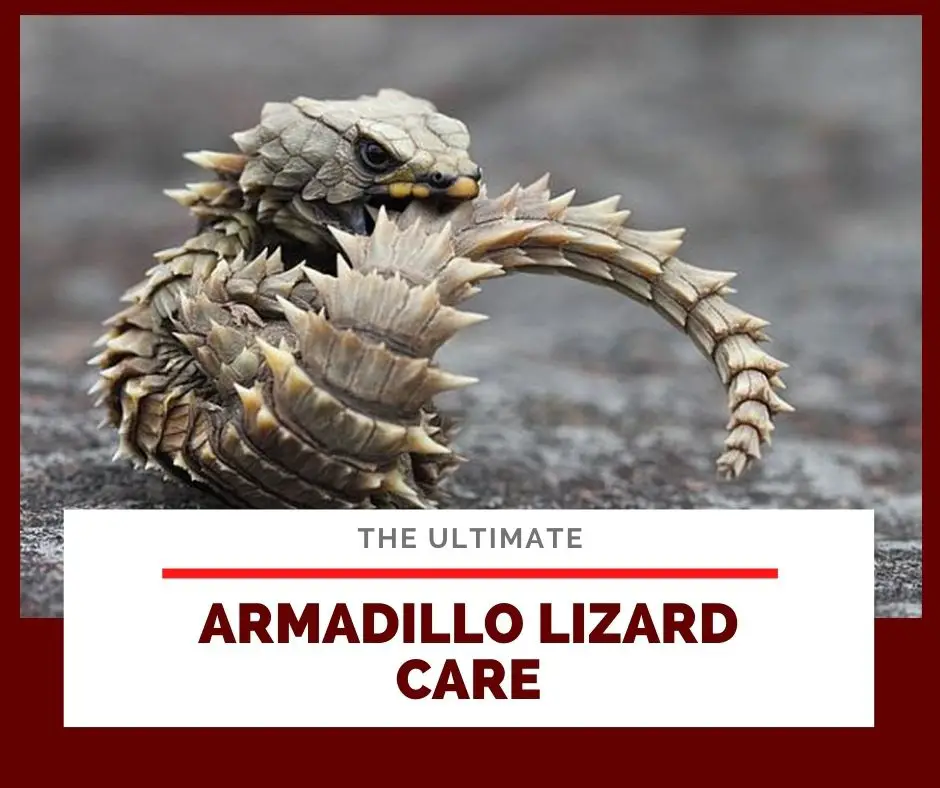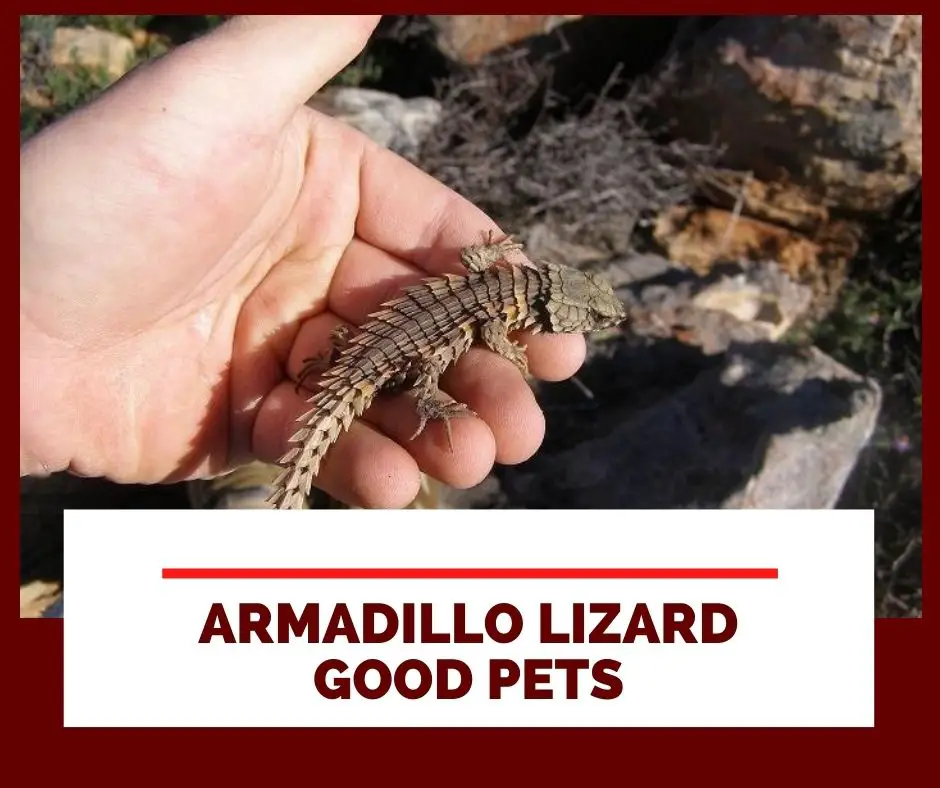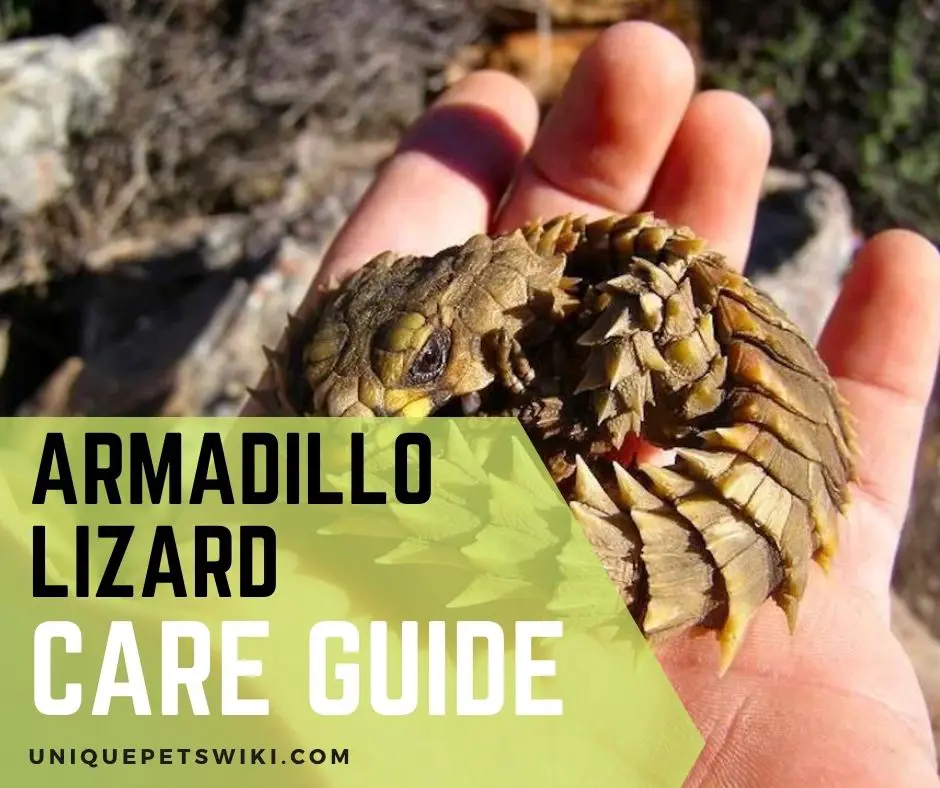Are you confused between getting a golden-armadillo lizard, armadillo girdled lizard, or the armadillo spiny-tailed lizard as a reptile pet? Don’t worry, you’re not in a fix!
They are all the same!
This is the best part about getting an armadillo lizard! It does not have a bunch of different species all over the world. Why is this a pro for you?
This alone makes the very first step of getting a pet infinitely easy. Yes! The first step – researching what food, environment, conditions and care your pet needs.
This step can be a real hassle for beginners, especially, when the type of pet you get has close relations and resemblance to other species of its genome. What’s even more troubling about this pickle is the health hazards involved, in case you mistake your pet for another species and provide it with the wrong conditions and care.
With that getting out of your way! You can fearlessly search for care instructions for the armadillo you’re going to get or already have. But what’s the need to research any further?
Here! You have stumbled upon the perfect armadillo lizard care guide to be a better keeper to your pet. This article consists of everything you need or will need to handle and keep an armadillo lizard.
Contents
What Are Armadillo Lizards?

Armadillo Lizard Species Profile
| Scientific Name | Ouroborus cataphractus, Cordylus cataphractus |
| How Much Do Armadillo Lizard Cost? (Average Price) | Between $100 to $1000 |
| Most Expensive Breed | Bronze casting armadillo lizard |
| Captivity Size | 7.5 to 9 cm (3.0 to 3.5 in), It may grow to a maximum size of 8 in |
| Captivity Diet | Crickets |
| Tank Requirement | – Size: 30-50 Gallons – Daytime temperature: 80℉ – 85℉ – Basking Spot: 115℉ – 130℉ – Basking Hours: 7-10 hours a day – Humidity: 45% – 55% – Substrate: Sand |
| Care Level | Intermediate |
Appearance and Origin
Armadillo Lizards are mostly found in east and south Africa but have also been spotted in West Africa.
They are often considered a desert animal, but surprisingly enough, they are a savanna reptile. Their natural habitat consists of grassy Savannas, upturned dirt, sandy patches, and muddy floors around watering holes.
Armadillo lizards have a dark head and back with patterns that form spots or stripes commonly golden brown, or yellow in color.
One famous characteristic of these lizards is a dark brown or black stripe that runs down the sides of their bodies.
They have pretty husky spikes throughout, lining their tails.
Gender Differences and Mating
A little sexual dimorphism exists in Armadillo lizards. Nevertheless, all hatchlings look alike until they start to reach sexual maturity. At that point, they develop the following characteristics:
- The females are more likely to develop a reddish or “rosy” throat, however, some males might also grow similarly if they do not develop a yellow throat.
- A female will have a more triangular and slim head.
- Females may reach a length of 15cm/6in, whereas a male is likely to grow up to 17.5cm/7in from snout to vet on average.
- Males on average tend to have larger femoral pores.
It’s usually very difficult to tell the sex of an unconfirmed armadillo lizard. However, it gets easier if you have a confirmed sex one to compare with.
Why Do Armadillo Lizard Make Good Pets?

These Armadillo lizards of African origin have been increasing in popularity throughout the pet market due to their unusual behavior – the ability to curl into a ball, protecting their soft underbellies, and displaying their hard, spiny, and scaly back – and manageable size.
Although non-orthodox in appearance and perks, these adorable little lizards require only basic reptile care.
15 Fun Facts About Armadillo Lizard
You probably heard Armadillo lizards are intriguing creatures! Let’s see why!
- They curl up into a hard rock type ball like an ouroboros!
- They can bite so hard as to break their own jaws!
- They can cut their tails themselves to distract and escape predators!
- They have very few predators due to their armored scales and hardened spines!
- Armadillo lizards aren’t in any way related to armadillos!
- Armadillo lizards don’t lay eggs!
- They can reach a weight of up to 8 kg!
- Armadillo lizards are actually cold-blooded animals!
- Armadillo lizards are omnivores!
- Their appearance makes them look like small dragons!
- They hate living alone in the wild. They are usually found in a community of up to 70 at a time.
- They love to switch these communal groups every now and then.
- Female Armadillo lizards can choose to take a break of up to a year between birth-giving.
- They are easy to catch due to their slow movement- and now they are an endangered species.
- Their trade has been announced illegal to avoid illegal possession.
The Cost of Caring and Raising an Armadillo Lizard
How much do Armadillo Lizard cost
Armadillo Lizards cost up to more than $1000 depending on their size, beauty, and gender. They are a little pricey given the fact that they are a rare species that do not breed in great numbers.
Golden dragons can be a bit pricey – around $1000 to $2000 – majorly because they are very rare and do not reproduce in large numbers like many other lizards.
Although, these tiny pet dragons mostly just require regular reptile care. All you need is a regular tank, a regular heating unit, and a cheap supply of crickets for its daily diet.
Cost for Cage Setup

The tank setup for Armadillos is no biggie! A thirty-gallon glass tank will be perfect. That’ll probably cost you around $200 along with an under-the-tank heating system for approximately $20.
Now, these prices might vary based on where you live or what market you get your supplies from. And probably also on your bargaining skills!
Cost for Food
These pretty little lizards sound very fancy! But when it comes to caring for them, they are so low maintenance. All they need in a healthy diet is crickets. You can get a pack of 50 for $2.
Cost for Cohabitation
Considering the additional setup and Armadillo lizards, it can cost you around $2000 to $2200 before you can see a pair of Armadillo lizards in your tank.
Cohabitation for a prolonged period can affect the growth rates of Armadillo lizards. Keeping two together will require at least a 40-gallon glass tank and a bit of luck. Their reaction to cohabitation varies on an individual basis. This will further decide what measures you need to take to help them get along.
Medical Costs for Armadillo Lizard
It generally costs around $10 to $15 to cover up for the monthly health insurance.
However, a proper vet visit can cost up to $80 to $100 depending on the region and pet store.
Where Can I Buy an Armadillo Lizard?

A small hindrance in getting your own armadillo lizard is the fact that their trade has been made illegal around some states and their export from South Africa is also under watch. This all is subject to the fact that they have recently come on the list of mildly endangered species.
Pet Stores
Due to their unusual and exotic look, armadillo girdled lizards are often collected from the wild in South Africa and then sold in pet shops around North America and Europe.
Although these mini dragons are not easy to find in regular pet shops. You might need to research a little and look around to find one. These natives of South Africa are illegal to trade in many countries and that leaves you with the option of captive Armadillo Lizard.
Pros
- Live inspection available before purchase
- You can determine if they are tame or not
- You can learn about their history and preferences beforehand
Cons
- Only a handful of stores have the access to keep them
Breeders
It would be safe to say that they are hard to breed species. Armadillo Lizards are one of the very few to not lay eggs. Rather the female gives live birth to 1-2 babies annually in winters.
However, many pet stores like Backwater Reptiles and Reptile City have earned themselves a good reputation in the breeding game.
Pros
- Instant shipping
- Allows you to choose gender preferences
- Range of payment methods available
Cons
- Live inspection is not possible before the purchase
- Some may not offer a return policy
Classified Ads/Facebook Groups
Several Facebook groups are operating to sell Armadillo Lizard. However, availability and international shipping have always been an issue amid all the sanctions imposed.
Pros
- Instant shipping
- Allows you to choose gender preferences
- Range of payment methods available
Cons
- Live inspection is not possible before the purchase
- Some may not offer a return policy
- Prone to scams.
Reptile Rescues
Armadillo Lizards are under a threat with a diminishing population with time. This has attracted the attention of certain organizations that are now working to flatten the curve.
CapeNature Conservation Services and Sanbi Organisation are notable names in creating awareness and raising the issue at global forums.
Home Setup for Armadillo Lizard
Your lizard should feel at home even if it’s living in an urban city apartment! Setting up a terrarium is one of the most important things you can do to care for your reptile.
Tank
An Armadillo lizard needs at least a 20-gallon tank. Although for a better and more comfortable environment, it’s better to get a 30-gallon tank with base heaters.
Basking Accessories Like Branches, Rocks, and Hidey-Holes
You need the right substrate for your arid-climate friendly pet – shredded bark or reptile liner. Have fun with your Décor just as long as you provide hiding places for your baby dragon to escape to and release stress in.
Moreover, you can place rock structures and branches so that your armadillo can get some control of thermal regulation for themselves. They love to be close to the basking bulb when they feel cold and blunt structures can be their stairs to get close to their bonfire.
An Armadillo lizard loves to pass time by digging tunnels for themselves and Zoo Med Excavator Clay Burrowing Substrate can give life to their dream.
Dishes and Bowls
Choosing the right crockery can help your Armadillo Lizard in many ways. Make sure their food bowls are wide and shallow. They fulfill most of their daily water requirement through green vegetables but they might need soaking to help them shred.
Wide, shallow and smooth dishes will serve the purpose without posing any harm to your pet. Exo Terra Water Dish for water and Fluker’s Reptile Bowl for food will go hand in hand together.
How Do I Choose the Right Armadillo Lizard for Me?
Armadillo Lizard Health Checklist
These golden lizards are tough little creatures and pretty resilient! Although there are a few things that show if the armadillo lizard you are getting is healthy or not.
- It should be tolerant of handling
- It should be docile and calm
- It should bask frequently
- It should eat lots of food
- Occasionally hide under rocks
Some signs of it being sick are:
- Excreting pus around the mouth area
- Uninterested in food or not biting food
- Swelling in the rear legs
Have Fun with Armadillo Lizard
Armadillo Lizards appreciate all sorts of entertainments. Toys and games keep them engaged and stimulate activity helps to keep them in tip-top form. They get bored in the four walls of the enclosure, eating, resting and patrolling their tank.
A hammock, climbing vines and ball can be a great way to start off. Observe how your pet responds to them. If it’s a yes, then fill up the space with exciting cool stuff to strengthen your bond with your pet.
Ultimate Armadillo Lizard Care Guide
Up until now, we weren’t focusing on a particular aspect of the care routine for your dragon! Instead, we discussed in general how you should keep it and have fun.
From here onwards, let’s get serious and talk about responsibility!
Diet
Armadillo lizards are actually omnivores! They majorly eat small insects or spiders, however, in the wild, their most important prey item is the termites. That does not mean giving them plant-based food is not an option, although keep in mind that the juveniles should exclusively be given a 100% insect-based diet.
But you need not worry! We are here to describe all you need to do in great detail.
What Should I Feed My Armadillo Lizard?
In captivity, you should stick to giving them small invertebrates like:
- Medium crickets for young ones
- Occasional bee moth larvae
- Roaches such as dubia, and hissing
- Super worms are a great choice
- Waxworms and silkworms are healthy alternatives
For adults, you might mix it up with pinkie mice and greens such as:
Collard greens
- Peas
- Carrots
- Watercress
- Turnips
- Dandelions
As dietary supplements, you may give them gut load and dust crickets with calcium powder to attain proper nutrition.
What Should I NOT Feed My Armadillo Lizard?
Some common foods to avoid include mealworms, and many greens that can be toxic such as avocados, mushrooms, kale, cabbage, broccoli, chard, corn, cucumbers, radish, iceberg lettuce. Some other harmful substances are chocolate, alcohol, and caffeine.
As a rule of thumb, fruits and even other greens should always be fed sparingly.
Daily Feeding and Cleaning Routine
Are you a beginner looking forward to petting a lizard?
Armadillo is your best match!
They demand fairly less care comparatively and won’t demand attention. All you need to do is feed them once a day and keep a close eye on their eating schedule. Make sure they are bellyful of it and remove the residue food to maintain a proper diet cycle and avoid a mess.
Try to keep a good balance between a green diet and insect feeders to fulfill all the dietary requirements of your Armadillo. Also, make sure to add calcium dusting in their feeds to strengthen their bones.
Cleaning your Armadillo is an essential step towards a healthy and long life. It is ideal to clean Armadillo Lizard when they are out of their enclosure for interaction. However, weekly cleaning would do no harm as well. You can simply rub a soaked cloth on their body to clean waste off their body. And don’t forget to keep them in a dry warm place for a while after cleaning.
Handling and Bonding
Armadillo lizards are very friendly. You can take an idea of their warm nature by the fact that they usually welcome a partner to live with them. This is rare in the species of lizards.
Don’t worry if your pet is running away from you every time you walk past the enclosure. This is normal for the newbies as well as adults. The captives of the wild are not used to human interaction. They tend to run to their hiding, curl themselves up with their spiny tail and bite with their sharp little teeth in stress.
Are you wondering how to get them tamed? Stick with us and it will be a walk in the park.
To start off, go and sit by the enclosure and make yourself acquainted with each other. Once your dragon stops running away from you on your sight, it’s time to put your hand inside the enclosure to get a step closer to them. Lure them with their favorite food until they finally accept food from your hand.
Handle them carefully since they have spikes all over their body that have the potential to scratch your skin. Let them shuffle from one arm to another to make them feel free and limitless – Just like their days in the South African plains.
Bear in mind, never hold them from the tail as they can shed it off as a defense mechanism. Also, avoid keeping them in the open air for long periods to avoid getting the cold.
Shedding
Shedding is normal for Armadillo lizards. It is a process where their old skin sheds to reveal fresh new skin. The signs of shedding include pale dull skin with grey patches appearing on the skin.
In this period, your pet is looking for objects to rub the skin and get off with it. This may result in losing appetite or aggressive behavior especially when contact is made.
So can you help your Armadillo lizard in shedding?
Yes, you can!
Soaking in lukewarm water till shoulder depth for 10 minutes can be very helpful. This helps overcome the dryness and supples the skin to fast-forward the process of shedding. Moreover, you can designate a damp area in the cage to keep the moisture high on the shedding days.
Don’t employ any unconventional methods of shedding as it might be harmful to your pet. Shedding is inevitable and requires patience – For you and your pet both!
Bathing
A bowl of dechlorinated water should be provided at all times in the tank, preferably changed with clean water every day as the armadillo lizard is known to like soaking occasionally.
The water provided should be shallow, no more than up to the shoulders of your reptile. A shallow wide bowl could be used or the depth of the bowl can be lowered using large gravel that your lizard can not eat.
This is important especially if your pet is young and small as deep bowls can be difficult to escape, causing a risk of drowning.
Brumation
Brumation is a period of Armadillo lizard’s life where their growth and development takes a break. It happens in low temperatures when your pet goes sluggish and inactive. They prefer sleeping for the better part of the day and tend to lose some appetite too.
However, they do come out to eat and spend some time in their basking spot before heading back to their hiding. Keep a check on their food intake and don’t worry! Your dragon is just preserving energy for the upcoming season to entertain you.
Cleaning the Habitat
Armadillo Lizards nourishes best in a clean environment. Clean the enclosure regularly to avoid any skin infection or bacterial reaction. For most substrates, a scooper works perfectly to replace the substrate and clean the waste. It is convenient and quick to do in comparison to washing the enclosure in case of no bedding.
Also, make sure to disinfect the enclosure once a month to get rid of any bacteria. Fluker’s Super Scrub Organic Reptile Habitat Cleaner is a notable product to make cleaning quick and easy.
Armadillo Lizard Health Diseases and illnesses
- Mouth Infections
This infection is more serious than you think.
Apparently, it is just swelling resulting in redness of the mouth due to insufficient heat in cold temperatures. But it has the potential of taking lives if not treated seriously.
Place a thermometer inside the enclosure and keep a close look at the temperatures, especially in winters.
- Metabolic Bone Disease
UVB light compensates for the absence of sunlight to help the absorption of calcium. With little or no submission to UVB lighting, Armadillo Lizard may develop Vitamin-D deficiencies, stressful behaviors, and reduced diet-intake.
This can ultimately result in the development of Metabolic Bone Disease (MBD) which causes the bones of reptiles to become deformed and brittle.
This may, certainly, affect their growth and in a worst-case scenario, cause disability. Zoo Med Repti Basking Spot Bulb is one of the best sources of UVB light for your pet.
- Respiratory Issues
Armadillo lizards need warm temperatures of around 110-115 degrees Fahrenheit in their enclosure. At this temperature, their body functions perfectly in terms of digestion and respiration. However, increased humidity levels or low temperatures can result in respiratory issues.
Gasping, emitting mucus, and breathing heavily are the primary indicators that your pet is undergoing respiratory complications. In such a situation, keep them under a well-maintained basking spot and consult a vet for further advice.
Conclusion
This is all from this Ultimate Armadillo Lizard Care Guide for Beginners.
Armadillo lizards are the closest things to dragons on earth with their spiny-tailed and dark brown color. They are low-maintenance pets but rare and expensive to get hands on.
However, they can live up to three years with medium level care. This is a huge commitment and a perfect solution if you are looking for a long term partner.
Make sure you have contact with the right vet before you bring your pet home. It will save you from the last-minute rush.
This is all you need to know about this beautiful creature. Take care of these basic requirements, and your Armadillo lizard will pay back with a heavy dose of fun and entertainment for decades.
Leave a comment below if you have ever seen an Armadillo Lizard before.
